OZ4. CFCs Are Invented
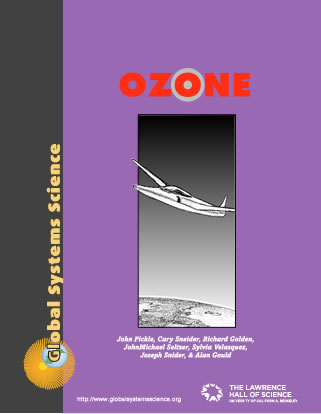
Chapter 4
{ Ozone Contents }
The previous chapter provided evidence of a link between thinning ozone, increased UV at the Earth’s surface, and the danger posed to humans and other living things. In this chapter we explore another clue to the puzzle: the existence of a new kind of gas in the air produced by only one organism we know of—human beings.
I. A Remarkable Compound
The year is 1930. A small group of executives gather in a laboratory in the E. I. du Pont de Nemours & Co. building in Wilmington, Delaware. Du Pont is one of the largest chemical manufacturers in the world. Thomas Midgley is demonstrating the properties of a new chemical compound he has discovered. At room temperature the new compound is a clear liquid. He proudly holds up a beaker of the material and pours it into the reservoir of a small electric pump. When he turns the pump on, the liquid is forced through a small nozzle into a long coil of glass tubing. But it is not liquid that emerges from the nozzle. It is an invisible gas that hisses into the glass tubing. The pressurized liquid turns to gas as it escapes into the space beyond the nozzle.
As the executives watch, frost begins to form on the nozzle and on the glass tubing. They touch the tubing. Near the nozzle it is very cold. As the molecules of liquid emerge from the nozzle they pick up heat from their surroundings and become energetic molecules of gas.
Next the executives examine the length of the tubing. At a distance from the nozzle the tubing is cool but not as cold as it was near the nozzle. They notice that further along the glass tubing droplets begin to form inside, until at the bottom of the coil the droplets run together and Midgley’s liquid compound drops out into another beaker. The liquid in the beaker and the tubing where the condensation takes place is warm to the touch.
Midgley bends down and takes the filling beaker back to the electric pump and pours the liquid into the reservoir. The cycle is repeated. There is an immediate stir of interest among those assembled in the laboratory. The application is obvious. Midgley’s liquid can be used for refrigeration.
In 1930, refrigeration was already a big industry. Ice making plants were in virtually every city. The large pieces of ice they produced were put on trucks and horse-drawn wagons and ice men would go from house to house selling pieces. The men would use picks to shape smaller pieces of ice to cool wooden ice boxes in every household. Air conditioners were unknown and some large theaters were cooled in summer by fans blowing air over large pans filled with pieces of ice. Far from the city, icehouses stored pieces of ice sawed out of lake ice that formed during the winter. Heavy layers of sawdust were used as insulation to keep the ice from melting well into the summer.
The ice making companies used concentrated ammonia or sulfur dioxide as refrigerants in their equipment. Both are toxic chemicals. Concentrated ammonia is flammable and sulfur dioxide is corrosive. They both required heavy pumps to move them through the refrigeration systems. Home refrigerators were beginning to be sold, but they used similar equipment and the same dangerous chemicals.
Midgley had demonstrated the superior efficiency of his new compound, and only a small pump was necessary to force the cooling process. But was the compound safe? Would the new compound burn in the air? Would it harm the eyes or lungs of the men who repaired refrigerators as the other refrigeration chemicals did? Thomas Midgley lit a candle and placed it on the table top. He leaned over a beaker full of his compound and took a long breath of the vapor that was evaporating from the surface. He turned to the candle and slowly exhaled toward it. The candle went out.
Breathing in an unknown gas is something that chemists are trained never to do. But Midgley had previously tested the vapors of the new compound on mice and birds and had observed that they experienced no adverse effects. “Gentlemen,” he said proudly, “although my refrigerant liquid is made of the toxic elements chlorine and fluorine, the carbon atoms in the compound hold them together so tightly that those dangerous gases are tamed. This compound is safe because nothing reacts with it. It is unique. It does not occur in nature. It is completely man-made. It is useful and it is not dangerous at all.”
The marketing people at du Pont were soon selling large quantities of Midgley’s refrigerant under the trademark name Freon. The chemical name for the compound is CFC-12. In 1931, 545 tons of the product were produced. Despite the restrictions of a World War II economy, by 1945, 20,000 tons were being produced annually.
II. Thomas C. Midgley Jr.
Thomas C. Midgley Jr. was a passionate inventor with a goal of improving the world by advancing technology. Two of his inventions were of truly global significance: leaded gasoline and Freon, the first of the chlorofluorocarbons (compounds of chlorine, fluorine, and carbon). Both of these inventions revolutionized technology, global development and economies, initially helping to preserve the environment, yet eventually wreaking havoc on the global environment.
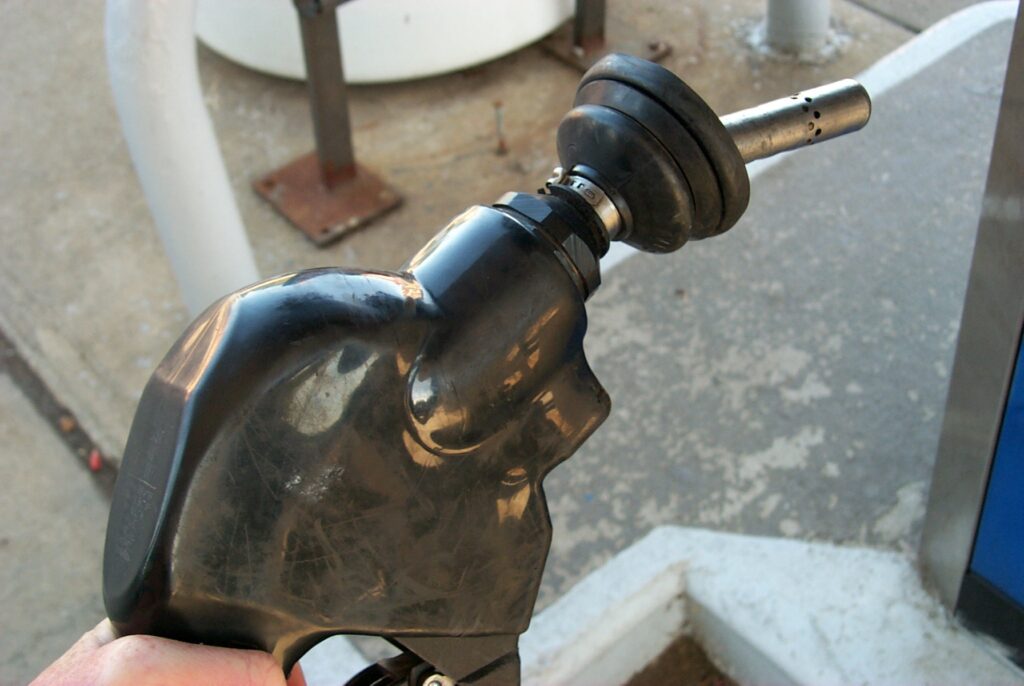
Gasoline, CFCs, and ozone.
They are interrelated.
Photo by John Pickle.
Midgley’s vision was to use technology to improve the quality of life. He imagined there would be pills that controlled people’s moods and how often they needed to rest, artificial hormones to stimulate growth and production of farm animals, and modes of telecommunication so efficient that people wouldn’t need to travel any longer. Interestingly, many of his technological visions have been attained much quicker than he anticipated.
Born in 1889, Midgley earned a Ph.D. in engineering at Cornell. In 1916 he joined a laboratory in Dayton, Ohio. While he was working on a method to improve aviation fuel’s performance during World War I, a piece of equipment exploded, embedding pieces of metal in Midgley’s right eye. Although the larger pieces were removed, almost 50 small metal specks remained to seriously impair his vision. Based on his knowledge of metals, Midgley tried mercury to save his eyesight. Although difficult to contain and quite toxic, mercury was known to amalgamate (form an integrated whole) readily with other metals. By bathing his wounded eye in purified mercury daily for two weeks, he thoroughly cleansed the eye of all the remaining metallic flecks and saved his eyesight.
Midgley’s work on fuel arose from the need to have engines burn fuel more efficiently and safely. The types of fuel were changing, and the fuel at the time, kerosene, caused knocking, a metallic sound resulting from the unbalanced burning of the fuel in the engine’s cylinder. Knocking could be so severe that the engine’s metal pieces would crack. He spent six years searching for an additive that eliminated knocking. He only spent three days discovering CFCs!
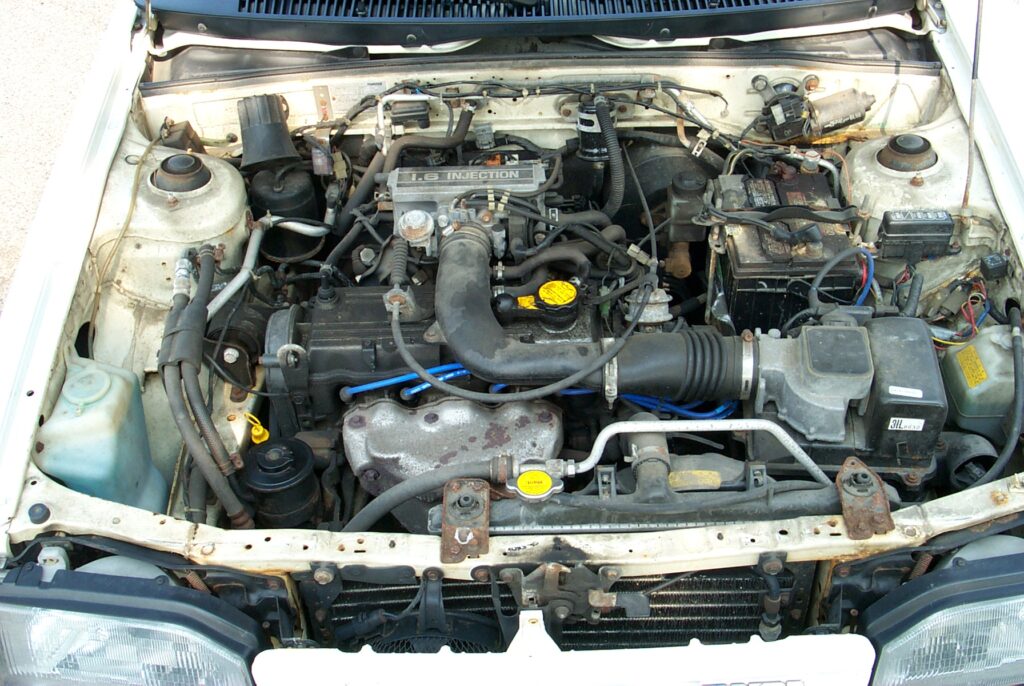
In 1922, he discovered that tetraethyl lead was an efficient anti-knocking agent that didn’t hurt the metal of the engine. Iodine also stopped knocking; however, it corroded the engine’s metal parts and is quite toxic to living organisms.
Today’s car engines would not have evolved without Thomas Midgley’s inventions
(Photo by John Pickle.)
Midgley’s discovery allowed for more powerful engines to be built, changing the face of all modes of transportation at the time. Lead was known to be harmful to humans, but it was used in the United States until 1990 when technology advanced to burn safer fuels in engines.
Unfortunately, Midgley contracted polio at the age of 51. Ever the inventor, he created a system of leather harnesses, pulleys, and cables to allow him to get into and out of bed under his own control. Accounts differ to the cause of his death, but he became entangled in the cables and died in 1944.
Due to the global economic impact of his two famous inventions, early writers praise every aspect of the man and his work. Today, because of the environmental impact of these inventions, some recent accounts villainize his work. What is fair? His inventions made engine fuels and refrigeration technology much safer at the time. How would the world have developed without his contributions?
III. What Is A CFC?
A CFC is a molecule that consists of atoms of chlorine (which has a periodic symbol of Cl), fluorine (F), and carbon (C). It may also contain hydrogen (H) atoms. In order to save time and ease communications, an industry standard was created to name CFCs. For most other molecules, people state the number of atoms in the molecule to create a molecular formula, such as H2O or CO2. CFCs are often described as CFC-11 or CFC-114, not the normal style of a molecular formula. What does this mean?
Codes for CFCs are in the form CFC-XYZ
where
X is the number of carbon atoms in the molecule minus 1.
[If X=0 (1 carbon atom in the compound),
then X is omitted from the code.]
Y is the number of hydrogen atoms plus 1.
Z is the number of fluorine atoms.
As an example, suppose a compound has 2 carbon atoms, no hydrogen atoms, and 3 fluorine atoms.
X = 2 carbon atoms ‑ 1 = 1
Y = 0 hydrogen atoms + 1 = 1
Z = 3 fluorine atoms = 3
Therefore, the compound would be coded CFC-113.
If the XYZ number has only 2 digits, then we assume X=0, meaning the molecule has one carbon atom.
Example: What is the chemical makeup of CFC-11?
X = 0 = 1 carbon atom ‑ 1
Y = 1 = 0 hydrogen atoms + 1
Z = 1 fluorine atom
You’re probably wondering, “Who made up this crazy scheme!?” Well, we won’t fix any blame here, but somebody else came up with the amazing “rule of 90”: If you add 90 to the CFC number, you don’t have to add or subtract from the number of hydrogen or carbon atoms, because the resulting 3-digit number represents exactly the number of carbon, hydrogen and fluorine atoms! For example, the 11 of CFC-11 becomes 101, or 1 carbon, 0 hydrogen, and 1 fluorine atom.
Question 4.1
Figure out the number of carbon, hydrogen, and fluorine atoms associated with each of the following CFC codes:
CFC-12, CFC-13, CFC-114, CFC-115
And what about the “chloro” in the chlorofluorocarbons? How do you know how many chlorine (Cl) atoms are present? The number of chlorine atoms in a CFC molecule depends on the number of unfilled outer electron shells of the other atoms. But without even knowing what electron shells are, the following mathematical expression (or magic trick, depending on how you want to look at it), gives the number of Cl atoms when you know the number of C, H, and F atoms in the compound:
Cl = 2(C+1) ‑ H ‑ F
Example: For CFC-11,
Cl = 2(1C +1) ‑ 0H ‑ 1F
= 4 ‑ 1
= 3 chlorine atoms.
Therefore, the chemical formula for CFC-11 is C1H0Cl3F1 = CCl3F
Example: What is the chemical composition of CFC-12?
Using the rule of 90, 12 becomes 102, so there are 1 carbon, 0 hydrogen, and 2 fluorine atoms. Then the number of chlorine atoms is
Cl = 2(1C +1) ‑ 0 H ‑ 2F = 2 Cl atoms.
Therefore, CFC-12 = C1H0Cl2F2 = CCl2F2
Question 4.2:
What are the chemical compositions of CFC-113, CFC-114, and CFC-115?
IV. How Do You Make a CFC?
Although CFCs are quite safe for people to use, the components used to make CFCs are quite hazardous. How did Midgley make the first CFC? Why would someone put together several dangerous components and expect a safe product to result? How would you find the mechanism to safely make the deadly materials change their bonding? And once you have completed the experiment, what do you do to find out if the final product is safe to breath, not explosive, corrosive, or toxic, and actually is beneficial for people to use? Being an inventor requires patience, insight, and a spirit that does not give up after failure but rather learns from setbacks. It also doesn’t hurt to have a bit of luck, a keen sense of observation, and unfailing curiosity.
The early production of CFCs was quite dangerous. The basic process consists of taking a hydrocarbon compound (materials consisting of hydrogen and carbon atoms, such as gasoline, motor oil, diesel fuel, methane, propane, and butane) and replacing some or all of the hydrogen atoms with either chlorine or fluorine. The chlorine and fluorine atoms came from gaseous compounds containing these atoms. Many chlorine-containing gases are quite corrosive as well as toxic. Gaseous fluorine compounds are quite explosive, and many an inventor, scientist, engineer, and technician has lost body parts while experimenting with these gases. Over time, the processes to create CFCs were refined and became safer.
The revolutionary invention of TeflonTM occurred during experiments to make new forms of CFCs in the late 1930s. As a precaution to prevent a particular gaseous fluorine compound from exploding, the pressurized cylinder was stored in dry ice. When the researchers went to use the gas, nothing came out. They discovered that the combustible gas chemically transformed to a solid inside the cylinder, creating the nonstick plastic we know today. We use it to coat nonstick cookware as well as industrial equipment requiring exceptional resistance to high temperatures, chemical reaction, corrosion, and stress-cracking.
V. New Uses for CFCs
Another large chemical manufacturer, the Dow Chemical Company, discovered another use for CFCs in the early 1940s. When liquid CFC-12 was vaporized and blown into liquid plastic, closed-cell bubbles formed around the gas as the plastic solidified. The plastic became rigid and lightweight and is a very good heat insulator.
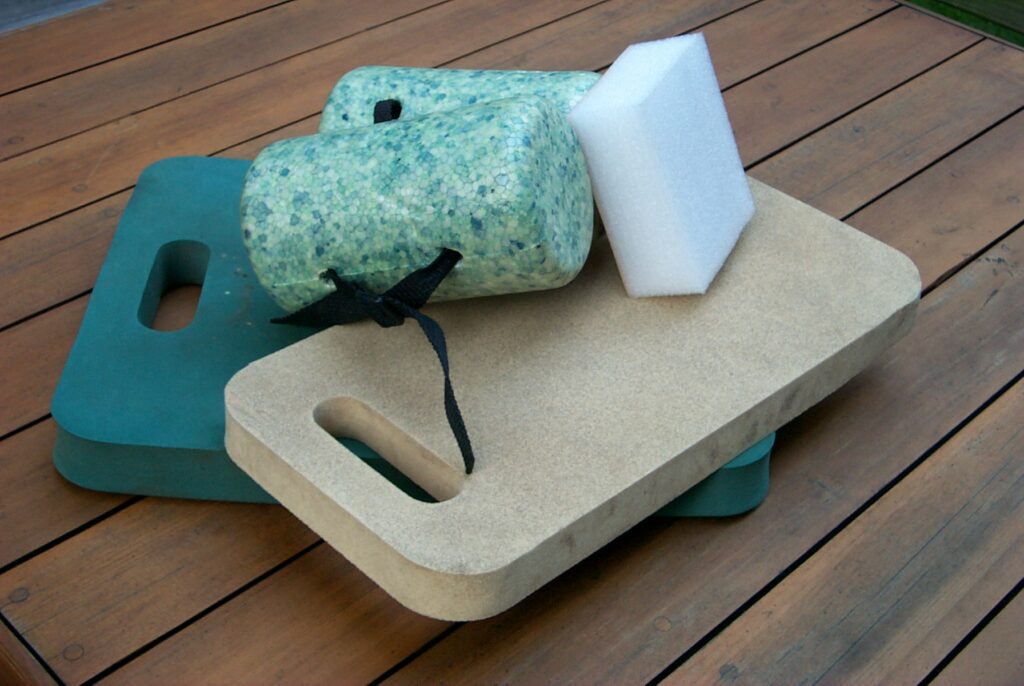
StyrofoamTM was born. During the next five years the production of CFC-12 doubled.
Styrofoam lead to other foam products that have many common uses.
(Photo by John Pickle.)
New uses for these remarkable compounds that appeared to be completely safe developed quickly. The basic formula could be slightly altered to produce different effects. CFC-11 was devised and used as a foaming agent to produce soft foamed plastic products like furniture cushions, carpeting, and automobile seats. Because CFCs were so stable, they could be packed with any product without fear of changing the product itself. At room temperature, CFCs in sealed cans turn to gas and the pressure buildup forces the product out of the container. The term “aerosol spray” became well known. It refers to a flow of gas in which there are tiny droplets of fluid suspended. Introduced in 1943, the use of CFC-pressured aerosol cans became commonplace all over the world.
Around 1960, the production of CFCs began to rapidly increase. By 1974, the dominant use of CFCs was as an aerosol propellant for products ranging from hair sprays to spray paint (which incidentally spawned new dimensions in graffiti technology and the graffiti removal industry).

By 1994, there were four primary uses of CFCs: propellants, refrigerants, cleaning agents, and foaming agents. Air conditioners were manufactured at a rapid rate. Artificial cooling of places of business and entertainment became common and home cooling allowed comfortable living in areas of the country previously too hot for comfort.
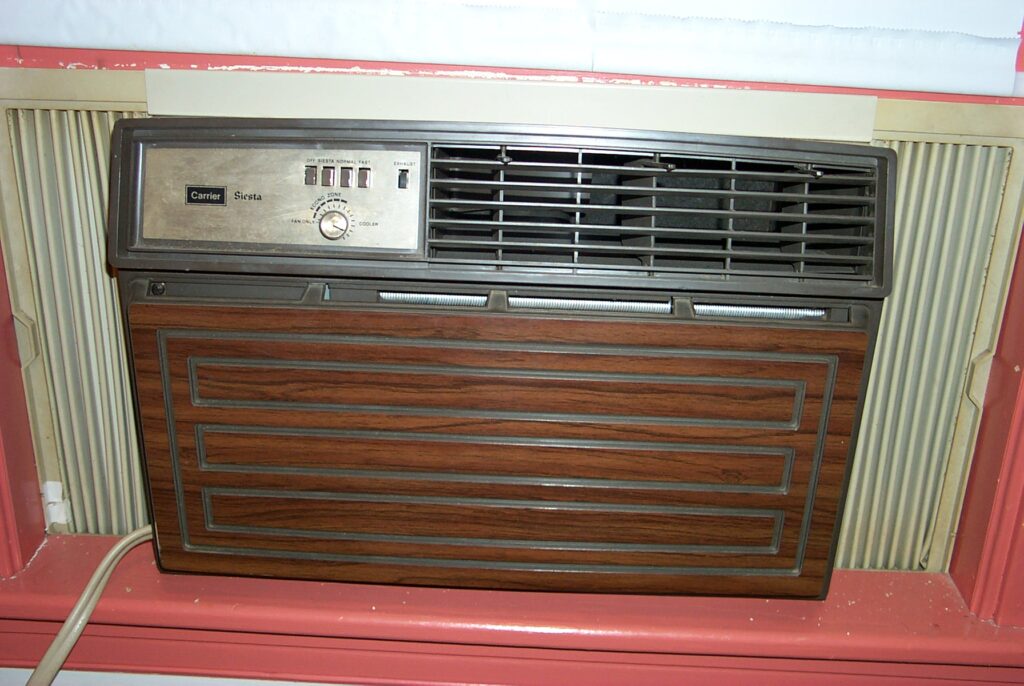
CFCs became a safe, efficient refrigerant, changing the lifestyles of many people around the globe.
(Picture by John Pickle.)
It became possible to build high-rise office buildings and shopping malls where people could work and shop in the height of summer. Air conditioners are now built into the majority of the automobiles sold in the United States.
VI. What Is Dry Cleaning?
Oddly, dry cleaning involves washing clothes in a liquid. However, the liquid is not water. Certain fabrics such as wool, silk, and rayon, may shrink, the dye may run, or be damaged in other ways if saturated with water and heated. Evidence that the Romans in Pompei used a turpentine-like liquid as a cleaning agent indicates the dry cleaning profession dates back roughly two thousand years.
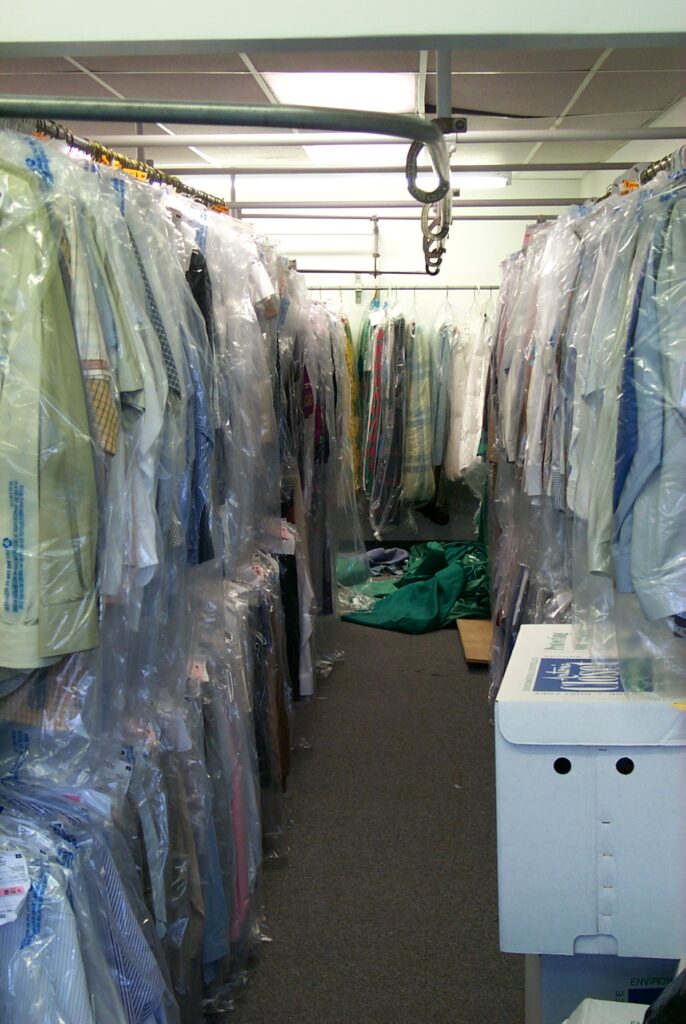
The dry cleaning process has changed significantly over time, with the greatest change occurring in the type of liquid used to clean the clothes. Even today the industry is changing as it seeks cleaner, safer, healthier cleaning solvents that are still efficient and economical. Dry cleaning is big business as it generates over $5 billion in sales each year in the United States alone. With over 30,000 dry cleaning operations, a safer, cleaner technology would affect a significant portion of the environment.
Clothes have gone through the dry cleaning process.
(Photo by John Pickle.)
VII. Are CFCs Really Safe?
The fact that CFCs do not react chemically very easily means that they are stable, last a long time, and are very safe for many applications. They seem like the perfect man-made chemicals! It was not until recent years that a down side to CFCs was revealed. The down side has to do with how they interact with ozone.

